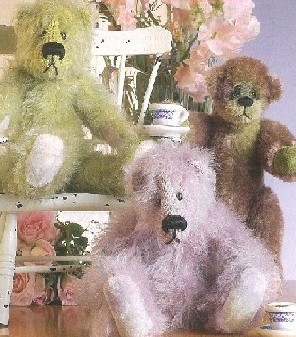 |
Three Teddies are all hand dyed mohair.
|
Capturing the
Rainbow
Mohair – Kick it up a Notch
An Introduction to Dyes
by Kathy Glenn
Why Dye?
When you look at the rainbow of colors that mohair suppliers offer these days, you might ask yourself, “Why should I dye my own mohair? Every color I could possibly want has already been done.”
It is true that over the last 10 years, the mohair manufacturers and suppliers, following the artist’s suggestions, have created fabulous
colors for their product lines.
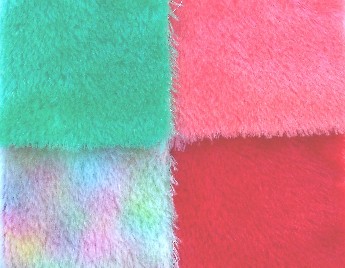 |
Reds and Greens
top left - Food Coloring
top right - Kool Aid (1 pack, cold water)
bottom left - Food Coloring, dropped
bottom left - Kool Aid (3 packs, hot water) |
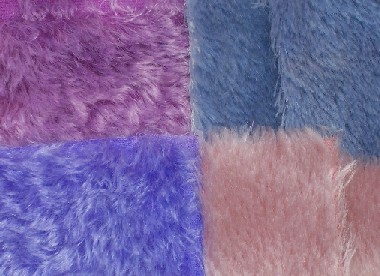 |
Purples
top left - Rit Dye - Aubergine
top right - Dyna Flow Fabric Paint
bottom left - Hair Coloring
bottom right - Procion MX |
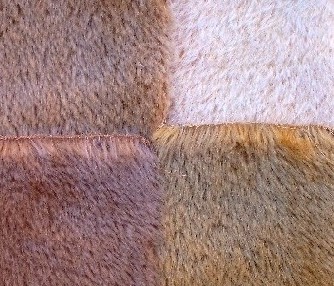 |
Tans
top left - Tea
top right - Red Clay Soil
bottom left - Cracked Pecan Shells
bottom right - Coffee |
However, artists and collectors are always looking for something out of the ordinary, something not everyone else will have, or something unique to one special creation.
There is always going to be that left over piece of mohair with which you are bored. Or, perhaps that the quality of mohair you want is not available in the color you want.
Dyes can be the answer!
Dyes are used to create new colors,
alter existing colors, and add texture
and interest to fabrics.
Color is what dyeing and patterning fabrics is all about. Color is an emotional thing.
We associate certain colors with specific emotions and how they make us feel.
The study of color theory helps us understand color relationships and
why different color combinations are pleasing or disturbing to us.
When bears “speak” to collectors, color
is a big factor. A bear in baby pink fur
will not evoke the same emotions as
the same bear in brilliant fuchsia.
History
Dyeing fabric is an ancient craft and
for over a millennium, dyes originated from plant and animal sources.
No source was considered too radical
to use; vegetables, berries, roots, flower blossoms, insects, and even crustacean shells were commonly used.
A highly prized shade of scarlet was derived from dried bodies of pregnant
lice that lived on Mediterranean evergreen shrubs.
It was so popular that in 1464, Pope
Paul II decreed that it be used to dye
the robes of the Catholic Cardinals.
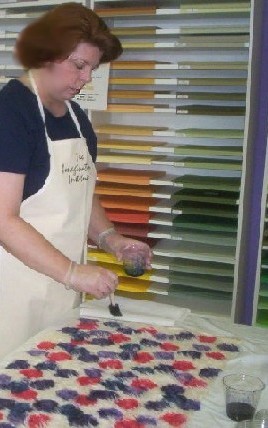 |
| Kathy Glenn dyeing mohair. |
In 1856, a British student, William
Henry Perkin, inadvertently created
the first synthetic dye when his
attempt to synthesize quinine,
resulted in a brilliant purple stain.
He secured a patent, quit school
and began to market and sell dye commercially. Others quickly followed
and the textile industry was forever changed.
Types of Dyes
There are four major classifications of dyes; direct, acid, fiber reactive and natural dyes.
DIRECT DYES – The most well known
is RIT Dye. These dyes are widely available, economical and easy to use.
Drawbacks include the fact they are not as wash fast as other types and tend to lack
the brilliance that can be achieved with acid and fiber reactive dyes.
Heat is normally required to set the dye before use.
ACID DYES – Particularly recommended for wool, silk and other
animal fibers. Sometimes called “protein dyes”.
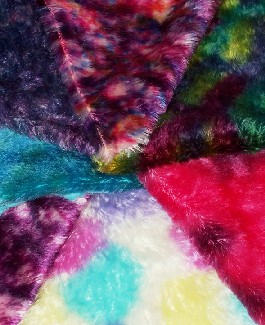 |
| Kaleidoscope pic of acid dyed mohair |
These dyes are not dangerous despite their name, which is derived from the need mix them with salt and an acidic medium to bond to the fabric. Several common acidic mediums include: vinegar, citric acid and ammonium sulfate.
Some dyes in this classification can be used with cold applications and never have to be heated, reducing the fabric shrinkage. The Australian Earth Palette Acid Dyes are in this category.
FIBER REACTIVE DYES – Used specifically on cellulose fibers such as cotton, linen, rayon, and on silk.
Fiber reactive dyes bond to fabrics in a unique molecular process, which ensures light, wash fastness and brilliant colors. Procion MX is a popular brand
among home dyers.
All fiber reactive dyes need an alkali activator/fixative such as Soda
Ash to prepare the fiber molecules to accept the dye. These dyes
can usually be used at room temperature.
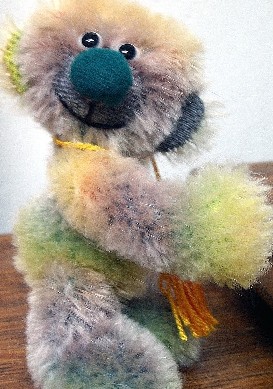 |
Portly
A gem at 5 inches tall, brewed from unusual short-pile string mohair, hand-dyed in bright stripes, large green suede nose and paws, glass eyes, cotterpin joints, plus a deeply abiding attraction to cookies! $119 (NZ) plus shipping from Bear Essentials.
|
Quilters use this type of dye for their creations. Bear Artists can use them to dye the cotton backs of the mohair without changing the fur color.
NATURAL DYES – Many common plants and trees can be used for dyes. Numerous books are available on natural dyeing that detail which parts of the plants are used, as well as recipes for making natural dyes.
The variety of colors you can generate from the same plant is quite amazing. Roots, stems, leaves, berries and flowers from
the same plant, can each produce different dye colors.
Changing the mordant (a mineral salt, usually a metal) will change the colors
again.
Protein fibers take natural dyes well. Due
to it’s molecular structure, silk will take the colors differently.
Plant fibers dye well but take longer
to absorb into the fibers.
Kitchen Dyeing
Your kitchen contains many items that can be used to alter fabric color
with outstanding results. Tea, coffee, bottled food colors, unsweetened
Kool Aid, nut shells, mustard, spices, vegetable cooking liquids and wine
can be used to shade fabrics.
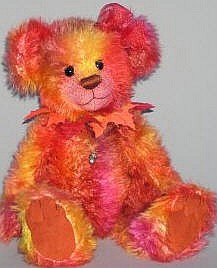 |
Autumn
Autumn is made of sparse Schulte mohair hand-painted with Earth Palette dyes. She has glass eyes, sculpted ultra suede paw pads, silk leaf collar with lucky golden acorn necklace and a red-orange hairbow. She is 15 inches tall, softly stuffed with fiberfill and pellets and is jointed.
Randi's Bears
Randi Robinson |
Rule of thumb:
If it stains your clothes, try it!
Normally, all of these dyes require heating the product with water and adding acid (usually vinegar) to set the color.
Concentration is the key to depth of color.
One packet of Kool Aid produces a light
but brilliant color while leaving a white backing, whereas six packets of Kool Aid
will result in a deep brilliant shade with lighter color on the backing.
Since mohair is an animal fiber and the
backing is cotton, both accept colors differently. Good note taking can result
in “recipes” you can reproduce time after time!
Have Fun
There is no better way to lose your fear
of dyeing than to just do it!
Like the fear of cutting into that first piece
of mohair, this too shall pass. Grab a friend and dye the afternoon away. Energize your creativity! Let your artistic juices and new ideas flow.
|


 3428 Hillvale Road
3428 Hillvale Road  Louisville, KY 40241 USA
Louisville, KY 40241 USA